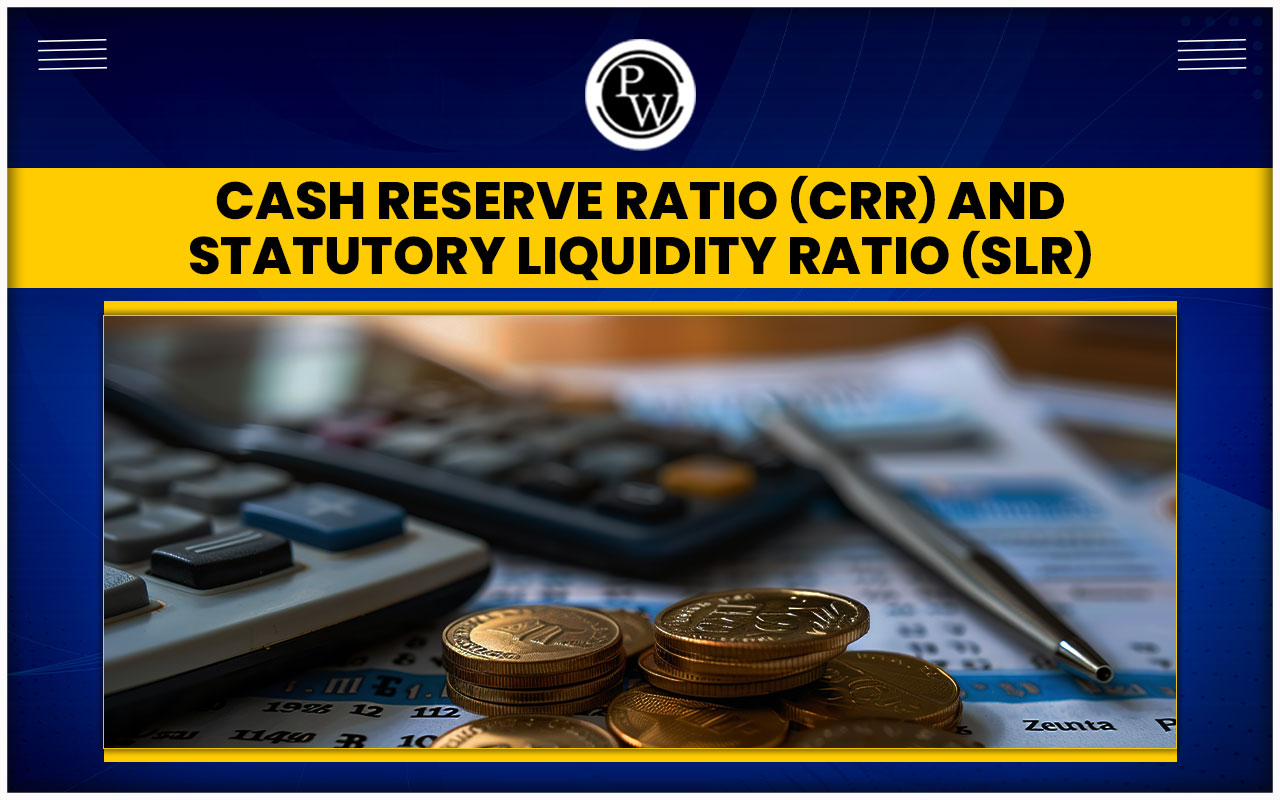

Cash Reserve Ratio (CRR) and Statutory Liquidity Ratio (SLR): The central sector of any economy is its banking sector. It often acts as a mirror of the entire economy and banking enables investment decisions to be made. Apart from repo ratio, reverse repo rate etc., the main components of banking are cash reserve ratio (CRR) and statutory liquidity ratio (SLR). These two ratios help determine the liquidity of the banking system and indicate the country's inflation and growth fluctuations. So let us understand what Cash Reserve Ratio (CRR) and Statutory Liquidity Ratio (SLR) mean and how they differ.
Cash Reserve Ratio (CRR)
As mentioned above, CRR stands for Cash Reserve Ratio. This is the reserve requirement that must be maintained by the central bank of the country - the Reserve Bank of India (RBI). Every commercial bank has to maintain CRR which is a certain percentage of their net demand and time cost. Commercial banks have to maintain CRR as cash balance with RBI. These banks are not allowed to use the funds for financial or commercial purposes. Basically, CRR represents the minimum percentage of deposits that a commercial bank must maintain with RBI as a cash reserve. RBI uses CRR to maintain liquidity and money flow in the economy.Advantages of CRR
- By adjusting the CRR, the RBI can control the amount of money banks can lend, which can help control inflation.
- This ensures that banks have a certain amount of cash, which promotes financial stability and reduces the risk of bank failure.
- CRR is an effective tool to regulate the supply of money in the economy, which can affect interest rates and economic growth.
Disadvantages of CRR
- High CRR can limit the amount of loans available to banks, which in turn can slow down economic growth.
- Money held as part of CRR does not earn interest, which can reduce the bank's profits.
- If the CRR is too high, it can cause solvency problems for banks, especially during times of financial distress.
Statutory Liquidity Ratio (SLR)
SLR stands for Statutory Liquidity Ratio. This is a mandatory condition to be maintained by commercial banks. Commercial banks can maintain this required reserve in the form of approved securities up to a certain percentage of net demand and current liabilities. SLR can also be defined as a tool used to maintain the stability of banks by limiting the credit limits they offer to their customers. Banks tend to hold more than the required SLR as per RBI norms, which require them to hold a certain amount of money as liquid assets. This helps banks meet the demands of their depositors as soon as they arise.Advantages of SLR
Banks maintain SLRs because of the following advantages:- SLR ensures that banks have a certain amount of liquid assets that they can use to meet customer withdrawals or other obligations.
- By requiring banks to hold a certain percentage of their liabilities as liquid assets, the SLR promotes financial stability and reduces the risk of bank failure.
- SLR can be used to monitor credit growth in the economy. When the SLR is high, banks have less money to lend, which can help curb inflation.
Disadvantages of SLR
- Limits lending: A high SLR can limit the money available for lending by banks, which can slow down economic growth.
- Reduces Banks' Profits: Assets held as part of SLR often earn less than other investments, which can reduce banks' profits.
- Can cause solvency problems: If SLR is too high, it can cause solvency problems for banks, especially during times of financial distress.
Difference Between CRR and SLR
Both CRR and SLR are integral parts of monetary policy. However, there are some differences between them. The following table shows the differences: 1. The cash reserve ratio (CRR) refers to the proportion of total deposits of commercial banks that they must hold as cash reserves at the central bank, while the statutory liquidity ratio (SLR) refers to the liquid assets that commercial banks are. required to hold daily. base as a percentage of their total deposits. 2. In the money reserve ratio, the central bank only holds cash, while in the statutory liquidity ratio, both cash and other types of assets such as gold and securities can be held. 3. The monetary reserve index regulates the flow of money in the economy, the liquidity ratio prescribed by law ensures the solvency of banks in the economy. 4. The reserve ratio is usually lower than the required liquidity ratio to maintain the solvency of commercial banks.| Difference Between CRR and SLR | ||
| Parameter | CRR (Cash Reserve Ratio) | SLR (Statutory Liquidity Ratio) |
| Definition | Percentage of total deposits that banks must maintain as cash. | Percentage of total deposits that banks must maintain in the form of gold, cash, or approved securities. |
| Purpose | CRR is used by the RBI to control the flow of money in the economy. It regulates the amount of funds that banks can lend. | SLR is used to ensure that banks have sufficient funds to meet the demands of their customers. It ensures the solvency of banks and encourages them to invest in government securities. |
| Impact on Interest Rate | Increased CRR leads to a decrease in the amount of money available for lending, thus, leading to an increase in interest rates. | Increased SLR reduces the funds available for lending, thus, leading to an increase in interest rates. |
| Penalty for Non-compliance | Banks failing to maintain the required CRR have to pay a penalty to the RBI. | Banks failing to maintain the required SLR have to pay a penalty to the RBI. |
| Form of Reserve | CRR is maintained as cash. | SLR is maintained as cash, gold, or approved securities. |
Cash Reserve Ratio (CRR) And Statutory Liquidity Ratio (SLR) FAQs
Q1. CRR and SLR stands for?
Ans. The CRR stands for Cash Reserve Ratio whereas the SLR Stands for Statutory Liquidity Ratio.
Q2. What is Cash Reserve Ratio (CRR) And Statutory Liquidity Ratio (SLR)?
Ans. The Cash Reserve Ratio (CRR) is the percentage of money that a bank must keep in cash with the RBI. Statutory Liquidity Ratio (SLR) is the ratio of liquid assets to time and demand liabilities.
Q3. What are the Advantages of SLR?
Ans. SLR ensures that banks have a certain amount of liquid assets that they can use to meet customer withdrawals or other obligations.
By requiring banks to hold a certain percentage of their liabilities as liquid assets, the SLR promotes financial stability and reduces the risk of bank failure.
SLR can be used to monitor credit growth in the economy. When the SLR is high, banks have less money to lend, which can help curb inflation.
Q4. What are difference between Cash Reserve Ratio (CRR) And Statutory Liquidity Ratio (SLR)?
Ans. We have tabulated above the differences between Cash Reserve Ratio (CRR) And Statutory Liquidity Ratio (SLR).
🔥 Trending Blogs
Talk to a counsellorHave doubts? Our support team will be happy to assist you!

Check out these Related Articles
Free Learning Resources
PW Books
Notes (Class 10-12)
PW Study Materials
Notes (Class 6-9)
Ncert Solutions
Govt Exams
Class 6th to 12th Online Courses
Govt Job Exams Courses
UPSC Coaching
Defence Exam Coaching
Gate Exam Coaching
Other Exams
Know about Physics Wallah
Physics Wallah is an Indian edtech platform that provides accessible & comprehensive learning experiences to students from Class 6th to postgraduate level. We also provide extensive NCERT solutions, sample paper, NEET, JEE Mains, BITSAT previous year papers & more such resources to students. Physics Wallah also caters to over 3.5 million registered students and over 78 lakh+ Youtube subscribers with 4.8 rating on its app.
We Stand Out because
We provide students with intensive courses with India’s qualified & experienced faculties & mentors. PW strives to make the learning experience comprehensive and accessible for students of all sections of society. We believe in empowering every single student who couldn't dream of a good career in engineering and medical field earlier.
Our Key Focus Areas
Physics Wallah's main focus is to make the learning experience as economical as possible for all students. With our affordable courses like Lakshya, Udaan and Arjuna and many others, we have been able to provide a platform for lakhs of aspirants. From providing Chemistry, Maths, Physics formula to giving e-books of eminent authors like RD Sharma, RS Aggarwal and Lakhmir Singh, PW focuses on every single student's need for preparation.
What Makes Us Different
Physics Wallah strives to develop a comprehensive pedagogical structure for students, where they get a state-of-the-art learning experience with study material and resources. Apart from catering students preparing for JEE Mains and NEET, PW also provides study material for each state board like Uttar Pradesh, Bihar, and others
Copyright © 2025 Physicswallah Limited All rights reserved.










